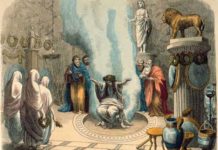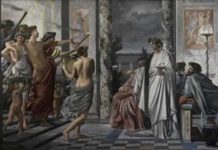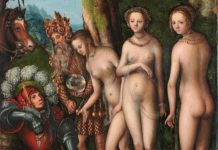The Delian League
With the final defeat of the Persians, mainland Greece was safe from invasion.
But now a most extraordinary thing happened.
In the winter of 478/7 a meeting was held at the island of Delos. Here, a group of independent Greek city-states, including Athens, decided to form a voluntary organisation called the League of Delos. The League was so named because its treasury was originally located on the island of the same name.
The objective of this league was to ‘compensate themselves for losses by ravaging the territory of the King of Persia’.
The Spartans decided not to join the Delian League, partly because they were not keen on waging a continual war against the Persian Empire, and partly out of a suspicion that this was only part of a greater design to set up an area of Athenian influence in the Aegean area.
With the Spartans out of the picture, leadership of the league naturally fell to the Athenians.
The Delian League pursued the conflict against the Persian Empire into Asia Minor, and later throughout the Eastern Mediterranean area.
The most influential Athenian leader in the immediate aftermath of the Persian Wars was the son of Miltiades – Cimon.
Plutarch tells us that ‘no man did more than Cimon to humble the pride of the Great King’. Plutarch actually wrote his biography of Cimon more than six hundred years after the actual events, and we should take his remarks with some caution. However, there is no good reason to doubt that there was some truth in what he says.
In 476 BC, Cimon led the forces of the Delian League to a major victory by capturing Eion, the last major Persian stronghold on the Hellespont.
Then, some years later, he scored his most spectacular success at the Battle of the Eurymedon, where he defeated the Persians both at sea and on land on the same day.
In 459, the Egyptians revolted against their Persian masters. The Delian League sent a force of 200 ships to assist the Egyptian rebels. Initially, the joint Greco-Egyptian forces managed to score some successes but this did not last for long.
Finally in 454 BC, the Persians managed to destroy the entire Greek fleet.
After this, no further major battles seem to have been fought between the forces of the Delian League and the Persian Empire. Some scholars have suggested that there may have actually been a Peace Treaty agreed upon by both sides.
Pericles
Pericles was born around 490 BC.
He was a member of the tribe Acamantis. His father was one Xanthippus, an Athenian general who had been in command at the battle of Mycale at the end of the Persian Wars. His mother, Agariste, was a niece of the great Cleisthenes, the man who had first established the democratic system in Athens.
Plutarch tells us that, with the exception of a disproportionately long head, Pericles had ‘near-perfect’ physical features.
There is another interesting story about Pericles that we know of from Plutarch. Once, it is said that he had been ‘abused and reviled’ for a whole day by an ‘idle hooligan’ while attending to his own affairs in the Athenian Agora. Even as he was returning home, his abuser continued to follow him and insult him. When, eventually, he had reached his own home, Pericles supposedly instructed one of his own slaves, it now being dark, to light a torch and escort the hooligan home.
(Stories from Plutarch should not be taken at face value, as he lived several centuries after the events that he was writing about. Nevertheless, it is an indication of the measure of admiration with which Pericles was regarded by the ancients)
In his youth, Pericles became associated with the philosopher Anaxagoras. It was mainly because of this association that Pericles, unlike most of his contemporaries, developed a non-superstitious mindset.
Pheidias, the great sculptor who created the famous gold and chryselephantine statue of Athena that was eventually to be housed in the Parthenon, was also closely associated with Pericles.
From the beginning of his career, Pericles became associated with the ‘democratic’ party in the Athenian Assembly.
The leader of the ‘democratic’ party in the first half of the fifth century was one Ephialtes.
Ephialtes was most famous for his successful reform of the Athenian political system, which stripped the old aristocratic governing council, the Areopagus, of most of its authority and left power in the hands of the people’s Assembly, the Ekklesia.
Ephialtes was assassinated for his pains in 462 BC.
After the death of Ephialtes, it was Pericles who became the leader of the ‘democratic’ party.
His main political opponents were the stalwarts of the ‘aristocratic’ party – first, Cimon the son of Miltiades, and later Thucydides the son of Melesias (not to be confused with Thucydides the historian!)
The achievement for which Pericles is most well-known is the construction of most of the buildings on the Athenian Acropolis, including the Parthenon. These projects were financed by money from the tribute payments made by the member states of the Delian League.
Pericles was also responsible for the construction of the Odeon.
From League to Empire
From as early as 470 BC, there had already been a certain amount of disaffection within the League of Delos. In that year, the island of Naxos, which was now no longer willing to provide money and ships for the use of the League, tried to withdraw from the League.
This did not go down well with the Athenians.
Naxos was forcibly re-incorporated into the League. It had to give up its fleet, and its defensive walls were pulled down. What was more, the Naxians now were obliged to contribute a fixed sum of money to the League instead of making a military contribution.
Then, in 465 BC, it was the turn of the island-state of Thasos to try and withdraw from the League. This attempt also met with a violent response from Athens and the other members of the League.
Thasos was besieged, and, after a prolonged defence, eventually capitulated. Like Naxos, Thasos was stripped of its defensive walls and its fleet, and had to pay an indemnity to the League.
There is no precise date from which we can consider the Delian League to have been transformed into an Athenian ’empire’. This never actually happened in an overt sense. Instead, the Athenians continued to maintain the fiction of a ‘voluntary league’ throughout.
However, most historians consider that from about the time at which the League’s treasury was moved from the island of Delos to the Athenian Acropolis (454 BC), the nature of the League can be considered to have changed into an ‘imperial’ structure in which Athenian hegemony was paramount.
Rivalry with Sparta
Right from the beginning, the Spartans had always regarded the Delian League with a certain amount of suspicion.
Sparta was at the centre of her own network of alliances, known as the Peloponnesian League, and she had always considered herself to be the “paramount power” among the Greek city-states.
The rise of Athenian power in the years after the Persian Wars was therefore a direct threat to Sparta’s position.
Initially, Sparta’s ability to respond to the Athenian challenge was hampered by major domestic problems.
First, in 464 BC, there was an earthquake which had devastating consequences on Sparta.
Then, the helots, who were the subject peoples of Sparta, rose in revolt, causing even more disruption to the Spartan state.
In 460 BC, the Athenians formed an alliance with the city-state of Argos. As Argos was one of Sparta’s traditional enemies, this act was bound to lead to open conflict.
Open warfare did indeed break out, culminating in the Battle of Tanagra in 457 BC. Although the Spartans did win a military victory in this battle, they were unable to follow through on their initial success.
Athens managed to recuperate and continued with the struggle.
Sporadic fighting continued throughout the 450s until in 446 BC, the two powers came to an understanding. A “thirty year peace” was signed, each power recognising the status quo and agreeing not to interfere in the other’s interests.
The Peloponnesian War
The peace between Athens and Sparta did not last very long.
Both sides continued to regard the other with suspicion.
Matters eventually came to a head in 433 BC, when Athens entered into a dispute with Corinth over a small city-state in north-eastern Greece called Potidaea.
Corinth was an important member state of the Peloponnesian League, and an important ally of the Spartans.
Although the Spartan king Archidamus argued in favour of a peaceful solution, there was so much animosity towards the Athenians among the Spartans that they voted for war by a huge majority.
The ensuing conflict was long and protracted.
Thucydides, the historian who has recorded the events of the first twenty years of the war, characterised it as ‘the greatest disturbance in the history of the Greeks’.
In the end, it was only with the aid of the Persian Empire that the Spartans and their allies managed to defeat the Athenians.
In 404 BC, peace was finally made.
Athens lost her ’empire’, her defensive walls were pulled down, and her navy was limited to only 12 ships.
Although Athens continued as an important state throughout the 4th century, her period of greatness came to an end with this war.








